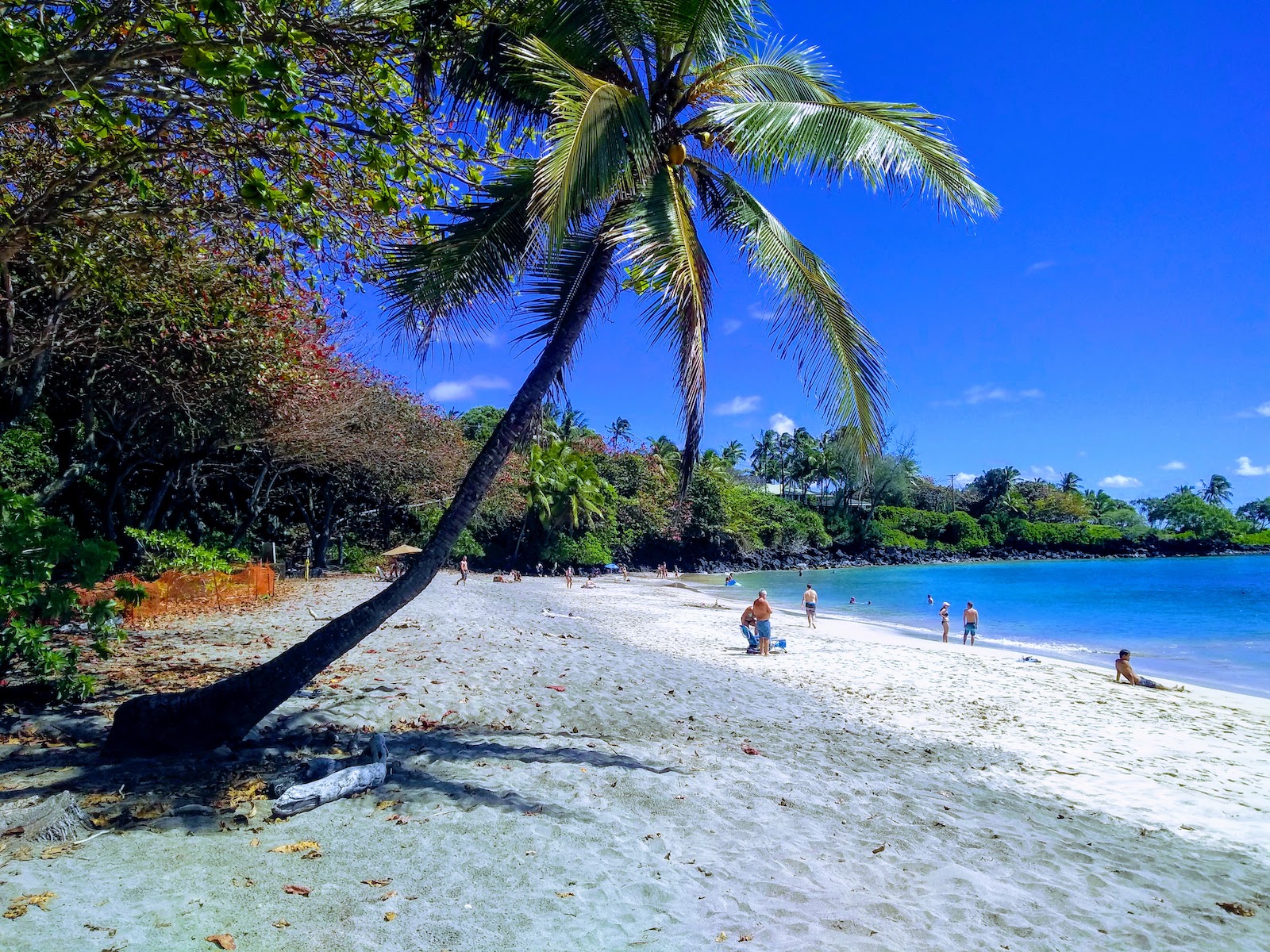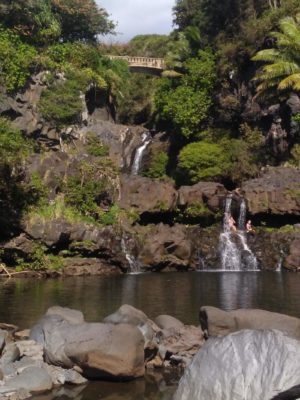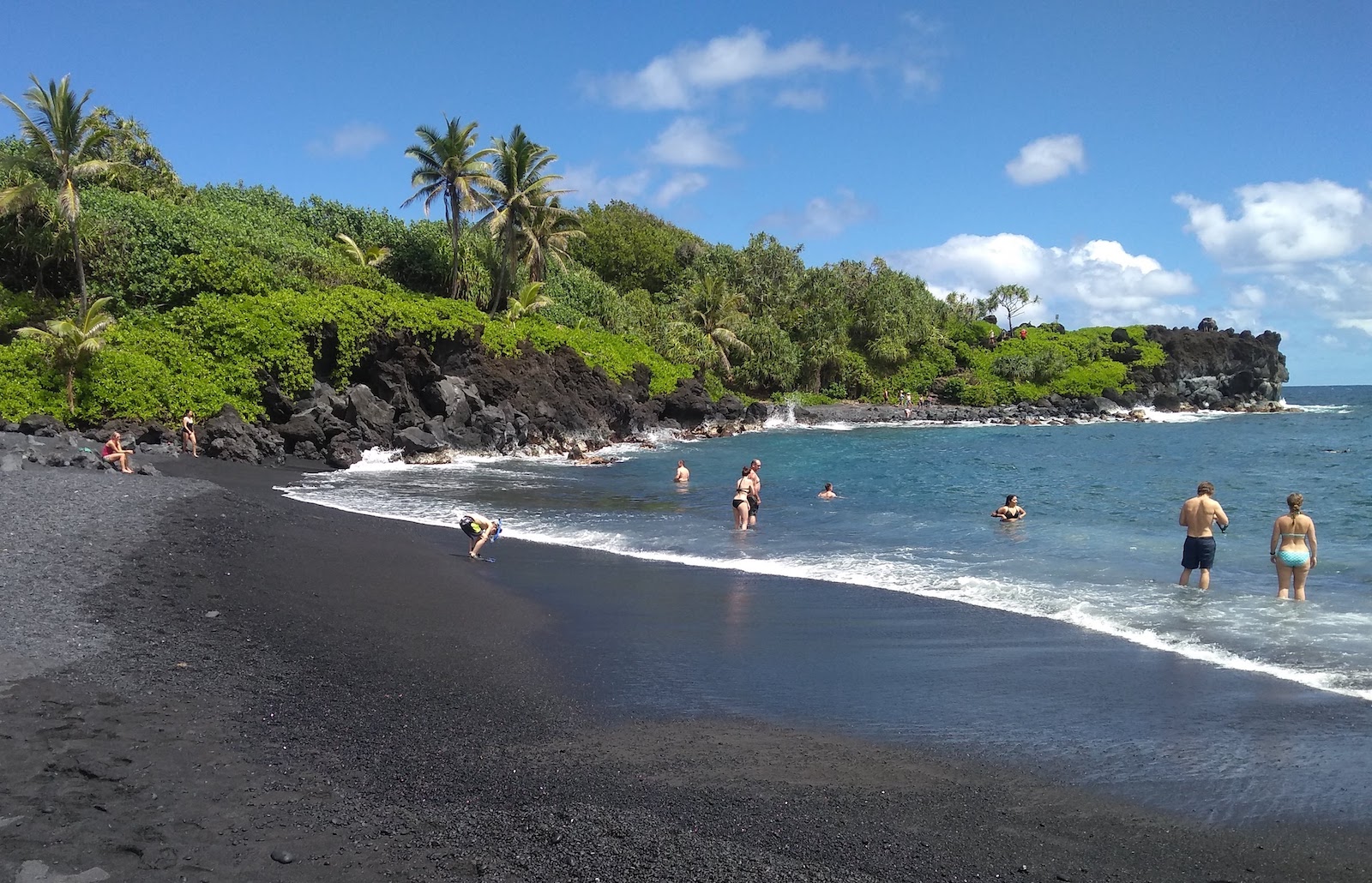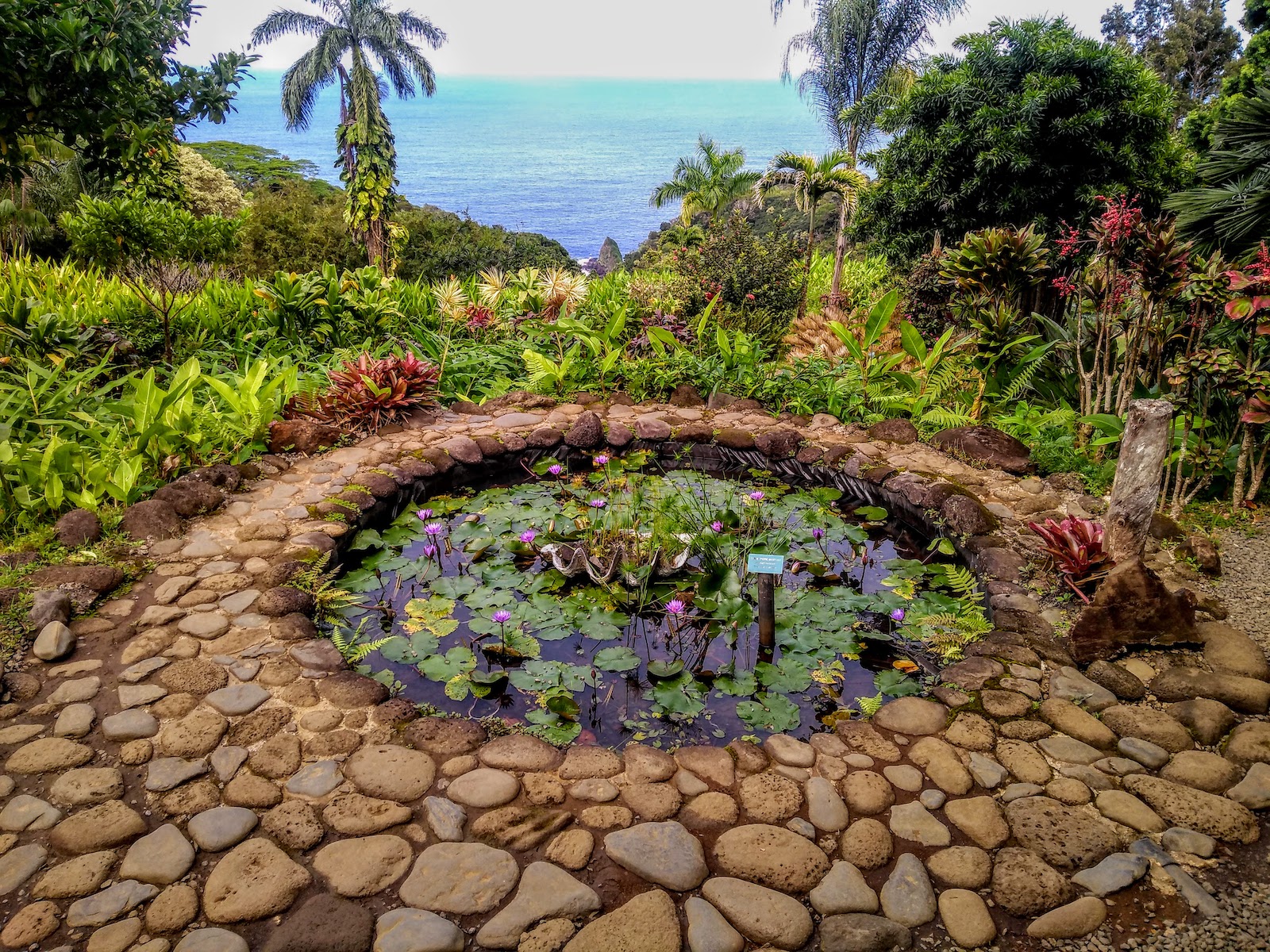
The Road to Hana Drive
This is a guest post from Jim at WINEtineraries.
What has 617 white knuckle turns, 56 one-lane bridges, steep drop-offs, and some of the world’s most spectacular scenery in a distance of just 52 miles? Answer: the road to Hana – which appears first on Travel + Leisure’s list of “America’s Most Scenic Roads.” This destination report is arranged by (sometimes non-existent) mile markers on the way from Paia town on Maui’s north shore to the Kipahulu Visitors’ Center of Haleakala National Park near the eastern tip of this island paradise and back.
Notes:
- I have included the Hawaiian directional terms “mauka” and “makai”, because you may find them used locally without explanation. “Mauka” means “toward the mountain” side of the road, and “makai” means “toward the ocean” side.
- This drive makes for a long day; we left our lodging in Wailuku at 6:00am and didn’t get back to Paia town until 5:00pm.
- Whatever you do, don’t underestimate this road! It is tiring (especially if you drive it roundtrip in one day!); the constant back-and-forth steering motion can become almost hypnotic.
- Build in plenty of stops to appreciate the scenery and break up the drive.
Mile marker 22.6 (both sides): Pua’a Kaa Wayside Park
Although you can view a waterfall (mauka) at this stop, I’ve included it primarily for two reasons: (1) ample paved parking (makai) makes it easy to get out and stretch your legs after driving about halfway to your turnaround destination, and (2) this is one of the few stops with restroom facilities along the road to Hana.
Mile marker 44.8 (mauka): Wailua Falls
Wailua Falls has been called Maui’s “most photographed waterfall.” This 80-foot cascade past Hana town is supposed to be easy to spot, but we drove right by it on the outbound portion of our journey. That’s because we passed by the unpaved parking area (makai) when there were no other cars there and before any vendors had set out their handicrafts.
Mile marker 42 (makai): Kipahulu Visitors Center, Haleakala National Park
This part of Haleakala National Park was the turnaround spot for our drive. Warning: Continuing past here may violate your rental car contract. Even the last mile or two before reaching our destination demonstrates why: the road is pock-marked with holes that can easily throw a car’s suspension out of alignment, if not break an axle. Drive slowly, bobbing and weaving as needed!
Tip: Having an “America the Beautiful” senior pass saves you the entrance fee of $30/vehicle. If you’re not a senior or are but don’t have the pass, save the receipt for your admission fee. It is good for 3 days, so you could also plan to visit the summit of Haleakala for no additional cost. The primary attractions here are the two trails:
Kuloa Point Trail

You may find this trail referred to as Ohe’o Gulch (actually the name of the valley through which the stream feeding the waterfalls flows) or the Seven Sacred Pools (a name coined by a hotelier to promote tourism). This unique geological feature was formed by Pipiwai Stream flowing over alternating layers of very hard lava deposited on top of softer rock over eons of volcanic activity.
The result is a picture-perfect cascade of relatively shallow waterfall-fed pools (there are many more than 7 when water levels are high!) capped by one of the bridges on the road to Hana (pictured here).
Warning: Despite its popularity, swimming here can be dangerous! Falls on wet rocks are common. Jumping or diving if you can’t clearly see what lies beneath the water’s surface is foolhardy. And your drive so far should have made it abundantly clear how remote this area is and, thus, how long it might take for emergency services to respond to an injury.
Pipiwai Trail
This more strenuous, 4-mile (roundtrip) trail follows the stream that feeds the pools below. Along the way, you get views of 2 waterfalls and, at the end, pass through an unforgettable bamboo forest.
Mile marker 50 (makai): Hamoa Beach (“The most beautiful beach in the Pacific”)

When pulling out of the parking area for the Kipahulu Visitor’s Center, reset your trip odometer to zero. After 7.5 miles, begin looking for a rather small white sign to Hamoa Beach (and, beyond it, Koki Beach). Turn right onto Haneo’o Road toward the ocean. After 0.4 miles, you will see a low rock wall on your right and cars parked along the left side of Haneo’o Road. This (or as close to it as possible) is where you park to access Hamoa Beach via the stairs at the far end of the rock wall. James Michener called Hamoa Beach the most beautiful in the Pacific!
Bonus: This crescent-shaped beach with near-perfect sand has public restrooms and showers, as well as a foot-washing station at the base of the steps to minimize the sand you carry into your rental car!
Mile marker 51 (makai): Koki Beach
Continuing in the same direction on Haneo’o Road will bring you to a large parking area and (probably) a food truck selling huli huli chicken (barbecued over mesquite; regularly basted with a glaze of pineapple juice, soy sauce, brown sugar, and sesame oil; and flipped – “huli” means “to turn” – to cook evenly and caramelize the glaze on the opposite side).
According to Hawaiian legend, the volcano god Pele fought her final battle with her sister, the goddess of the ocean, at Koki Beach. The dark red sand here comes from the nearby cinder cone hill — the Hawaiian name of which means “bones of Pele.” The riptide here is notoriously dangerous. Continue on Haneo’o Road, which loops back to rejoin the road to Hana, and then turn right.
Mile marker 32 (makai): Wai’anapanapa State Park
2.4 miles north of Hana, turn right onto Waiʻanapanapa Road and drive 1/2 mile to the large parking area for Waiʻanapanapa State Park. Note: Effective April 19th, 2021, all non-resident visitors must purchase both entrance and parking reservations online.
Warning: Waiʻanapanapa Road, especially the last 200 yards, is in very rough shape. Maneuver carefully to dodge the numerous, deep potholes and ruts! The main features here are the small but gorgeous black sand beach, freshwater caves, sea arches, and a small lava tube framing the ocean.

Bonus: The park has public restrooms with a foot washing station, boardwalk-like walking trails, and picnic tables. There is also a popular camping area, which requires an additional (paid) permit, which must be obtained well in advance.
Mile marker 31 (makai): Ka’Eleku Caverns (Hana Lava Tube)
Lava tubes are formed when, over time, a lava flow cools and hardens on the top, which is exposed to the air. As lava continues to flow beneath the hardened crust, the side walls are built up. Finally, as the flow slows, the floor of the tube is formed.
When avid spelunker Charles (Chuck) Thorne moved to Hana in 1988, he began hearing tales of a subterranean lava tube system nearby. It took him a few days to find the entrance hole (technically a vent) in a thickly wooded area on private property. Over the next 8 years, he explored and mapped the lava tube (the owner never set foot in it). When the 10-acre property was offered for sale in 1996, Thorne bought it as quickly as possible, and Maui Cave Adventures was born.
But before Thorne could offer his first tour, he had to prepare the lava tube for public use by hauling out more than 8 tons of cow bones (the cave was once used as a slaughterhouse) and install signage explaining the tube’s unique formations, like the bowling alley, a ceiling which resembles a carpet of inverted Hershey kisses, etc.
It’s only a short drive from Waiʻanapanapa State Park to the Hana Lava Tube (also called Ka’Eleku Caverns), the largest lava tube on Maui and the 18th largest cavern system in the world. Tours are self-guided and take about 40 minutes. The entrance fee is $15.
Mile marker 27.5 (mauka): Coconut Glen’s
In 2014, Conde Nast named the 100% vegan and organic ice cream (made with a base of coconut milk) served from this little shack the second best ice cream on the planet! Glen rotates the dozen or so flavors to take full advantage of seasonally-available ingredients, but original coconut, salted caramel, vanilla bean, and lilikoi (the Hawaiian name for passion fruit) are almost always available.
Mile marker 10.5 (mauka): Garden of Eden Arboretum

This 26-acre botanical paradise is the realization of a vision of Alan Bradbury, Maui’s first arborist certified by the International Society of Arboriculture. Part of the opening sequence of the 1993 film Jurassic Park was filmed here. That was three years before the Garden of Eden was opened to the public.
Following the extensive network of well-maintained nature trails is like walking through a rain forest where all the plants are labeled. Peacocks roam the grounds near the Art Gallery Gift Shop. There are overlooks to waterfalls that are closed to the public, a “Bamboo Alley,” picnic areas, and photo opportunities galore! Admission: $20.00 for 16 and up.
Tip: The adventure-minded can even rappel down one of the hidden waterfalls viewable from the Garden of Eden with Rappel Maui (separate business and charge).
Mile marker 2.1 (mauka): Twin Falls
Twin Falls is just a little over 2 miles after beginning the drive to Hana. But, if you delay your departure in order to arrive here when the gates open at 8:00am, you will have a hard time seeing everything described in this report. We decided to stop here on our way back, instead, and arrived here a little after the stated closing time of 3:45pm.
We found plenty of cars in the parking lot and the gates still open. To reach the viewing point for the falls, follow the well-worn path until it splits. Bear left and then walk about 100 yards along the shore of the stream back toward the entrance.
You survived!
Back in Paia town, you can relax your grip on the steering wheel, roam the unique boutiques like Alice in Hulaland, and grab some pupus (tapas) at one of the happy hours – Milagros Food Company is a good option – to celebrate completing your adventure on the Road to Hana.
For more on visiting Maui using points and miles, check out the Maui section of Travel To Hawaii for Free.



Thanks for the information on the Road to Hana. It’s always good to have information on the sights to see along the way.
Appreciate the detail and especially the warnings. Great write-up!
just did it early this month, but didn’t enjoy much as having only 1 day to do the road to hana & the sunset at the crater summit in national park; didn’t help that 1st half of the day was cloudy & rainy
I greatly appreciate the detail provided here. I can sink my teeth into each milestone as though I was on a treasure hunt! Unnecessary fluff and potentially dangerous pitfalls are avoided through reading this article. The small, historical facts of interest will definitely encourage me to revisit this area’s highlights with a new perspective. Many thanks!
What! No mention of driving beyond, and doing the full island circle? The, “minimal road maintenance beyond this point…” road, or whatever the sign said? You’ve not lived until you do it.
if the rental car happened to get stuck or damage on part of rocky / dirt road, coverages don’t cover & one will pay dearly
Absolutely true. Equally true, you pretty much can’t drive over 10 MPH, so the chance of damage from anything is very low, getting stuck zero, and so long as you make it out as pretty much everyone would, the rare case where some gravel damage is identified could have happened anywhere on the island. Now a flat tire, that would stink, but we had a full size car with full size spare, and no flat anyway. Still, the views / experience is once in a lifetime.
If I remember right, Charles Lindbergh’s grave is down there not too far down on that dirt road. It’s on a breathtaking vista of the ocean. I found that to be the highlight of my trip to Hana from Ka’anapali many many years ago. Not that I have become scared of heights I could never do that drive again.
Good write up, did this back in December and will remember it forever! Was probably the highlight of the trip. This article is a little confusing how the stops are ordered, it seems like he bounces around a bit geographically and unless you’re mapping it out, you don’t realize that half the stops are beyond Hana if you start out in Pai’a.
Fair point. So, to clarify, this drive began in Paia, passed Hana, went as far as many rental car agreements will allow, and turned around, ending back in Paia. Signage is, admittedly, confusing and, as I acknowledge, often missing entirely. All I can say is that it makes sense once you’re on your way. Enjoy this epic drive!
If you want a wild time, drive the back side. That’s where you want the jeep, but I did it in a Maxima. Make sure you research it first because it is a wild drive and there are customs on handling single lane blind curves, on a cliff without guardrails.
Just an FYI, effective yesterday 25 Feb, if your visiting the big island, Waipio Valley Road which is also popular the road has now been officially closed to visitors indefinitely.
Great information. Thank you.
Just did this in December and had a great time. We stayed at the Hyatt Hana. Four things I recommend.
A. Rent a convertible, and not a Jeep. The rain can come at any time and putting the tops on a Jeep in the rain is not fun.
B. Go past Hana for some of the best scenery and awesome waterfall.
C. Get the Gypsy Hana App for your phone. It uses your phone’s GPS to tell you what is coming, where to stop, where to eat, and works in both directions. I think it cost $10, but the best $10 I have spent in a long time.
D. Get some real grippy hiking shoes, as this is a rain forest and trails can be slick.
Great tips John – thanks!